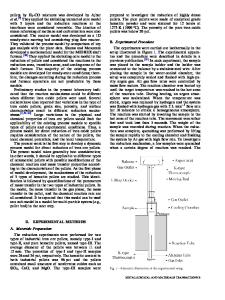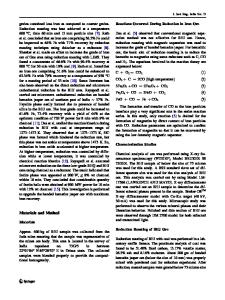Studies on the reduction of hematite by carbon
- PDF / 333,170 Bytes
- 4 Pages / 603 x 783 pts Page_size
- 65 Downloads / 367 Views
S Ton theUreductionDof ironIoxides Eby carbonS have been c a r r i e d out extensively.1-n It is generally a g r e e d that except under high vacuum conditions,2 reduction proceeds through gaseous intermediates according t o the scheme: FexOy + CO = FexOy_l + C02 C + CO2 = 2CO. Kohl and Marincek4 studied the reduction of various oxides of iron with graphite in a stream of nitrogen at 1000 to 1200°C. For wustite reduction, they observed an incubation period which was not observed during the reduction of higher oxides. The sharp inc r e a s e in reduction rate after the incubation period was attributed to the catalytic affect of iron on Boudouard reaction. Arkharov and Bogoslouskis also reported a minimum reaction rate before iron nucleation in the reduction of hematite and magnetite to iron with carbon. Kohl and Engel6 observed that the duration of incubation period and the amount of oxygen removed during that period are dependenton the initial oxygencontent of wustite. Eck7 observed that the rate of reduction of iron oxides by graphite in an inert atmosphere increases with the amount of graphite in the sample, attaining a limiting value towards higher carbon contents. Otsuka and Kuniis studied the reduction of ferric oxide by graphite in an inert atmosphere in the range 1050 to 1150°C. Their results indicate a two stage process in the first stage, ferric oxide is reduced to magnetite and then to wustite by CO generated by Boudouard reaction. In the second stage, the reduction of wustite proceeds autocatalytically and is greatly influenced by the particle size and bentonite. The activation energies associated with the two stages of reduction have been reported to be 60 to 70 kcal per tool at 20 pct reduction and 15 to 20 Kcal per tool at 60 pct reduction. Ghoshand Tiwari9 have also reported an activation energy of 18.5 Kcal per tool for the overall process for the reduction beyond 50 pct in iron oxide-lignite pellets. Ree and Tate~° investigatedthe effect of ambient N. S. SRINIVASAN, formerly Research Scholar in the Department of Metalturgy~Indian Institute of Science, Bangalore-5600 l2, India, is now Scientist, Regional Research Laboratory, Bhubenswan, India, and A. K. LAHIRI is Assistant Professor, Department of Metallurgy, Indian Institute of Science, Bangalore. Manuscript submitted September 1O, 1975. METALLURGICAL
TRANSACTIONS B
gas (N2, N~-CO, N2-CO2) on the reduction of magnetite anthracite pellet in the temperature r a n g e of 1000 to 1200°C. They observed that the reduction of oxide particles in the pellet proceeds topochemically. They further noted that the d e g r e e of reduction in the pellet core was much more than in any other region especially in case of N2-CO2 gas mixture. The authors report an increase in reduction rate with d e c r e a s e in particle size and increase in carbon~oxide ratio. Rao n c a r r i e d out experiments u n d e r a r g o n atmosphere and studied the effect of particle size, oxide// carbon r a t i o and the addition of promotive and inhibitive agents. H e observed that the
Data Loading...











